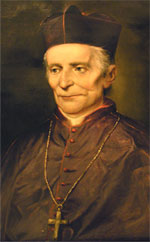The life and times of Bishop Simon Bruté
 During the summer of 2005, Archbishop Daniel M. Buechlein of Indianapolis dedicated a series of columns to looking at the life and times of his predecessor, the Servant of God Simon Bruté, the first bishop of Vincennes, Ind. (More information about his Cause of Canonization here)
During the summer of 2005, Archbishop Daniel M. Buechlein of Indianapolis dedicated a series of columns to looking at the life and times of his predecessor, the Servant of God Simon Bruté, the first bishop of Vincennes, Ind. (More information about his Cause of Canonization here)
Below, you can read each of the columns, or purchase the compilation in a booklet that was recently published. Right click on each of the  images and "Save target" to download an audio file of the archbishop reading his reflections (~2.5 MB each)
images and "Save target" to download an audio file of the archbishop reading his reflections (~2.5 MB each)
i.) Introduction 
1) A childhood shaped by life during the French Revolution—Gabriel Simon Bruté was born in affluence, but even as a child was forced to live his Catholic faith with extraordinary discretion. 
2) Gabriel Simon’s academic and medical background—He was an outstanding student and became a distinguished medical doctor. 
3) Vocation to the priesthood and missionary aspirations—Only later did Gabriel Simon Bruté de Rémur discern a vocation to priesthood—in spite of his mother’s strong and vociferous objections. 
4) Missionary to the United States: Priestly ministry in Maryland—Father Bruté wrestled with the desire to be a missionary to the Far East like St. Francis Xavier, but as a Sulpician priest he was sent to the United States instead. The focus of his ministry was that of theologian and teacher. 
5) Ministry at Emmitsburg, Md.—During his sojourn at Mount St. Mary’s in Emmitsburg, the spirituality and holiness of Father Bruté caught the attention of Elizabeth Ann Seton, who was later canonized for her holiness and charity. Father Bruté had become her spiritual director. 
6) A Pastor at heart—While he was highly respected as a theologian by the first bishops of the United States, Father Bruté was sought out for his sacramental ministry, pastoral wisdom and spiritual direction. 
7) Father Bruté ministers to a future saint—The life of the future bishop of Indiana was intimately tied to that of a future canonized saint for 20 years. 
8) Father Bruté is called upon to lead a new diocese in Indiana—In October 1833, the bishops at the Second Provincial Council of Baltimore sent the name of Father Simon Bruté to Rome to become the bishop of a new diocese to be erected in Indiana and Eastern Illinois—the Diocese of Vincennes. 
9) Bishop of Vincennes, 1834—Against his protestations and efforts to refuse his appointment as bishop of Vincennes because of what he considered severe pastoral, spiritual and physical limitations, Simon Bruté was named bishop of Vincennes in 1834. He had only two priests and one on loan to help found the diocese. 
10) Five years of effective ministry—As we will see, our first missionary bishop found peace of soul and accomplished extraordinary results in ministry in a short five years. 
11) The poverty and holiness of Bishop Bruté—A friend, Bishop Benedict Flaget of Bardstown, said: “An American missionary had to be able to live on nothing and cook it himself.” 
12) The illness and death of a simple bishop—Bishop Bruté was buried in borrowed clothes. His last words were those of Jesus on the Cross: “Sitio. (I thirst).” 
13) The process for the cause of canonization—On Dec. 4, 1891, while visiting Vincennes, Cardinal Gibbons said: “Worthy citizens of Vincennes, you need not go on pilgrimages to visit the tombs of saints. There is one reposing here in your midst, namely, the saintly founder of this diocese, Right Reverend Simon Bruté.” 
